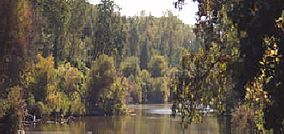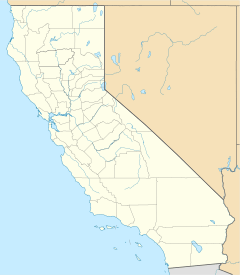Butte Creek Ecological Reserve facts for kids
Quick facts for kids Butte Creek Ecological Preserve and Butte Creek Canyon Ecological Reserve |
|
|---|---|
|
IUCN Category Ia (Strict Nature Reserve)
|
|

Lower Butte Creek
|
|
| Location | Butte County, eastern Sacramento Valley |
| Nearest city | Chico, California |
| Area | 378 acres (0.591 sq mi) |
| Governing body | California Department of Fish and Game / California State University, Chico Research Foundation |
The Butte Creek Ecological Preserve and Butte Creek Canyon Ecological Reserve are special natural areas in northern California. They are located east of Chico along Butte Creek. These areas are super important because they protect a vital part of Butte Creek. This part of the creek is a spawning habitat for the largest group of Central Valley spring-run Chinook salmon. These salmon are a "threatened" species, meaning their numbers are low and they need protection. Other fish like fall-run Chinook salmon and steelhead trout also lay their eggs here.
The California Department of Fish and Wildlife helps manage these areas. They see the Butte Creek Canyon Ecological Reserve as very important for wildlife. It protects critical shaded river and water resources. Besides salmon, the reserves also provide homes for other animals. These include the bald eagle, Swainson's hawk, beavers, and the western pond turtle.
There's also another nature reserve called the Butte Creek House Ecological Reserve. It's located at the very start of Butte Creek. The California Department of Fish and Wildlife (CDFW) manages this reserve too.
Contents
Exploring the Reserve Units
The Butte Creek Ecological Preserve and Reserve are made up of different parts. Each part helps protect different types of nature.
Butte Creek Canyon Unit
This unit is about two miles (3 km) southeast of Chico. It covers 255 acres (1.03 km2) of land. The California Department of Fish and Wildlife (CDFW) manages it. This unit has many non-native grasses. It also has some rare plants. These include the California black walnut (Juglans hindsii) and shield-bracted monkey flower (Mimulus glaucescens).
Virgin Valley Unit
This unit is 30 acres (120,000 m2) in size. It is also managed by CDFW. You can find it half a mile downstream from the Butte Creek canyon mouth. This area has forests of valley oak (Quercus lobata). These trees grow on terraces along the stream.
Honey Run Unit
The Chico State University Research Foundation manages this unit. It works with other groups to protect the area. This unit is 93 acres (380,000 m2) in size. It is located right within the Butte Creek canyon.
This area of Butte Creek has a long history. From the 1800s to the 1970s, people used it for mining sand and gravel. Later, there were plans to build homes here. But local citizens were worried about the nature. They worked hard to stop the building projects. A big flood in 1986 also damaged the area. Eventually, the land was bought by the California Department of Fish and Game and Chico State University. This helped protect it for nature. In 1998, Chico State University bought the Honey Run unit. They had help from different groups who wanted to save the land.
Butte Creek House Ecological Reserve
The Butte Creek House Ecological Reserve is at the headwaters (the very beginning) of Butte Creek. It is 110 acres (0.45 km2) of wetland meadows and forests. This reserve is near the base of Snow Mountain. It was bought in 1986 to protect and restore the area. This was part of a project related to a hydroelectric power plant.
The reserve is home to special plant communities. These include chaparral plants like greenleaf and pinemat manzanitas. You can also find bitter cherry and bush chinquapin here. These plants grow at different elevations, from 2,000 feet (610 m) up to 9,000 feet (2,700 m). The forests have lodgepole pine and red fir trees.
Amazing Restoration Efforts
Many groups are working together to restore the Butte Creek watershed. Environmental groups, landowners, and government agencies are all helping. Their hard work is really paying off! Rob Titus, a scientist from the Department of Fish and Game, said the restoration has shown "a measurable response."
Here's an amazing example:
- In 1987, only 14 Chinook salmon were counted in Butte Creek.
- By 1998, that number jumped to 20,000!
This huge increase shows how successful the restoration has been. Between 1994 and 1997, many improvements were made. Old farm buildings were removed. Special screens were put in to protect fish. A new fish ladder was also built to help fish swim upstream. Plus, a certain amount of water (40 cubic feet per second (1.1 m3/s)) is kept flowing in the creek from October to June. This ensures the fish have enough water.
Harry Morse from the California Department of Fish and Game said, "The spring run in Butte Creek is doing exceptionally well. For the fish, it's a success story..."
Other restoration work includes removing harmful invasive plants. These include star thistle, scotch broom, and Himalayan blackberry. Invasive plants can push out native plants. This can reduce the variety of life (biodiversity) and destroy habitats. The areas along the creek, called riparian zones, are most at risk from these invasive plants. Protecting these areas helps keep Butte Creek healthy for all its wildlife.


